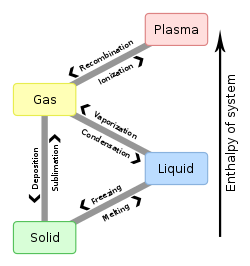Chemical ionization (CI) is an ionization technique used in mass spectrometry. Chemical ionization is a lower energy process than electron ionization. The lower energy yields less fragmentation, and usually a simpler spectrum. A typical CI spectra has an easily identifiable intact molecular species (e.g. a protonated molecule).
Mechanism

In a CI experiment, ions are produced through the collision of the analyte with ions of a reagent gas that are present in the ion source. Some common reagent gases include: methane, ammonia, and isobutane. Inside the ion source, the reagent gas is present in large excess compared to the analyte. Electrons entering the source will preferentially ionize the reagent gas. The resultant collisions with other reagent gas molecules will create an ionization plasma. Positive and negative ions of the analyte are formed by reactions with this plasma.
Primary ion formation
Secondary reagent ions
Product ion formation
- Â Â (protonation)
- Â Â ( abstraction)
- Â Â (adduct formation)
- Â Â (charge exchange)
Self chemical ionization occurs when the reagent ion is an ionized form of the analyte.
Variations

Negative chemical ionization (NCI)
Chemical ionization for gas phase analysis is either positive or negative. Almost all neutral analytes can form positive ions through the reactions described above.
In order to see a response by negative chemical ionization, the analyte must be capable of producing a negative ion (stabilize a negative charge) for example by electron capture ionization. Because not all analytes can do this, using NCI provides a certain degree of selectivity that is not available with other, more universal ionization techniques (EI, PCI). NCI can be used for the analysis of compounds containing acidic groups or electronegative elements (especially halogens).
Because of the high electronegativity of halogen atoms, NCI is a common choice for their analysis. This includes many groups of compounds, such as PCBs, pesticides, and fire retardants. Most of these compounds are environmental contaminants, thus much of the NCI analysis that takes place is done under the auspices of environmental analysis. In cases where very low limits of detection are needed, halogenated species are frequently analyzed using an electron capture detector coupled to a gas chromatograph.
Atmospheric pressure chemical ionization (APCI)
Chemical ionization in an atmospheric pressure electric discharge is called atmospheric pressure chemical ionization. The analyte is a gas or liquid spray and ionization is accomplished using an atmospheric pressure corona discharge. This ionization method is often coupled with high performance liquid chromatography where the mobile phase containing eluting analyte sprayed with high flow rates of nitrogen and the aerosol spray is subjected to a corona discharge to create ions.
References
External links
- Using Amines as Chemical Ionization Reagents and Building Custom Manifold



0 komentar :
Posting Komentar